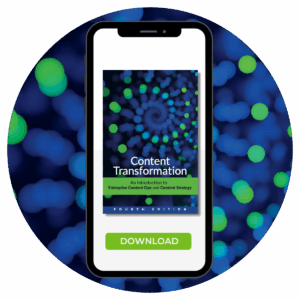Localization best practices (premium)
Localization—the process of adapting content to a specific locale—is a critical requirement for global companies. It’s often treated as a necessary evil, but this is shortsighted. The quality of localization efforts affects the company’s bottom line.
More than ever, products and services are sought, purchased, and consumed in multiple language markets. Proper localization practices are critical to drive sales, and they can save you time and money in production.
This article describes best practices for efficient, effective localization.
Your content is a business asset. It promotes your company and its offerings, drives sales, and supports customers. To ensure excellent localization, you must consider your global audiences and all aspects of content production—content development and management tools, content creation practices, and your content partners.
Use your tools wisely
Your content authoring tools and how you use them affect the efficiency and cost of the localization workflow. When choosing an authoring tool, evaluate how you will use it in localization. Every feature you use in your content will have a localization impact.
Reuse carefully
Content reuse helps reduce the number of words requiring translation, but be careful. Every block of reusable content needs to be complete. Paragraph level reuse—including notes, cautions, and warnings—is ideal.
Resist the temptation to maximize reuse with minuscule chunks (sentences, phrases, or even characters). These tiny chunks do not offer the translator enough context to understand and properly translate the text. (Think of a chunk that says “green.” Should this be translated as an adjective? What noun does the adjective modify? This matters in many languages. Is it perhaps a verb or even a noun–slang for money? The translator cannot necessarily tell from the isolated chunk.)
With larger blocks of text (entire topics or groups of topics), be mindful of the amount of conditional text needed to accommodate reuse.
Conditional approval
Conditional text helps you reuse content that is similar but not quite identical in multiple locations. Use conditional text sparingly.
Heavy use of conditional text is a sign that you should reconsider your strategy. This will save your sanity in authoring the content and avoid localization problems. Conditionalize only sentences and not phrases, terms, or single words. A small tweak in English wording often leads to a major change in other languages. Your word count will be higher if you conditionalize at the sentence level (rather than inside sentences), but the translation process will be smoother.
Templates
Regardless of your choice of authoring tool, use well-designed templates with explicit paragraph and character styles. (In Word, a document that uses only the Normal style is a very, very bad sign.) A cluttered, unmanaged document will require significant reformatting after translation. Reformatting lengthens delivery time and increases overall translation effort.
Consistent template use reduces post-translation reformatting effort, as style names are retained in the translated version. You should also create copies of your templates in all target languages with appropriate customizations (for example, replacing “Chapter” in English with “Chapitre” in French). When you apply the templates to translated content, formatting changes automatically.
XML and the evils of CDATA sections
XML separates formatting from content, which can alleviate translation formatting issues. A consistent structure is imposed by XML. Styles are applied at the time of publishing and not during the authoring process. XML can also contain translation instructions, such as identifying text that should not be translated. However, the type of XML you use and how it’s implemented in your authoring tools matters.
In particular, beware of character data (CDATA) sections. Many web content management systems use CDATA within the XML. CDATA allows the author to embed HTML code inside the content. This breaks the separation of formatting and content introduced by XML, eliminates XML’s ability to enforce structure, and allows the author to inject whatever code they want. Many translation tools have trouble working with CDATA sections. The translators either need to type the markup in their translations—reducing translation memory leverage—or develop custom filters to hide this markup, which will increase your translation cost and require ongoing maintenance.
Before implementing any XML-based authoring tool, understand how it fits within a localization workflow and what the XML looks like when exported for translation. Do not use CDATA sections.
Write for translation
During translation, a translation memory file is created. This file contains all of the text strings (usually stored as complete sentences) and their translations for each target language. When you send updated content for translation, that content is compared against the translation memory to determine what has changed and how much of the existing translations can be reused.
Many translation best practices are simply good writing rules:

City dwelling birds are modifying their songs to compete with city noise – Pixabay: LollemyArtPhotography
- Follow the style guide. Be consistent and follow your writing conventions. Small variations in the text may seem harmless (for example, “click OK” versus “click the OK button”), but they require different translations. Using a consistent writing style will increase your translation reuse, saving you time and money.
- Avoid rewriting existing content. Avoid editing content that has already been translated unless absolutely necessary. Every change you make decreases translation reuse–and increases cost. Just adding or removing a comma reduces your translation memory leverage.
One of the best ways to avoid these and similar issues is to document your writing guidelines. Style guides help with phrasing and other writing conventions. But there are other forms of content documentation that will help you improve your content and translations over time:
- A glossary can help you use the correct term or phrase in the correct context. With a bit of modification or enhancement, you can convert the glossary to a full terminology set for translation. It should include all of the correct terms to use (and avoid), along with their definitions and examples of use. Translate your terminology into all of your target languages to ensure that the same translation is used by all translators.
- If you are tailoring content for a specific cultural impact, capture all custom phrases (idioms, colloquialisms, and so forth) in a document along with their meaning and intended use. Your translators may be fluent in the target languages and cultural nuances, but they may not understand your intent. This document clarifies what you are trying to communicate, and facilitates development of custom messages with the same impact in the target languages.
Share these and other supporting documents with everyone involved with your content. You can use basic spreadsheets or sophisticated applications, but in either case, you will have better control over your content and how it engages your target audiences.
It’s all about images
The adage “a picture is worth a thousand words” describes the efficiency of graphic communication, but take this expression as a warning: Every graphic you translate can cost about the same as 1,000 words. Seems high? Consider the work involved in producing these graphics, and the impact they have on the audience and your company’s image if they are misunderstood. As with written content, graphics need to be handled with care and used strategically in order to be effective.
Screen shots
Screen shots are common in software documentation and often contain the text from the user interface. Here, you face a dilemma:
- If the interface is not translated, the translated text will be interrupted by a graphic in a language the audience may not understand. This can detract from the usefulness of your content and colors the reader’s perception of your company.
- If the interface is translated, you must recapture the screen shots. This can be a significant effort.
If you use localized screen shots, here are some best practices:
- Use a specific project and script for capturing all of your screens. This script should be appropriate for all of your intended audiences, and be followed in every language implementation.
- Only include a screen shot in your content when it is absolutely necessary for communicating a concept or action, and share these graphics with your translators for their review.
- Never use a screen shot to take up space or add visual appeal to content unless you are willing to invest the time and capital to reproduce (with modification, when necessary) this look and feel in all localized versions.
Other graphics
Other graphic assets come with their own localization considerations. If a graphic is paired with text (for example, diagrams or pictures with call-outs, or graphics with text flowing around them), consider how these elements should be positioned. Is it more culturally appropriate or expected that the text appear to the left or the right of the graphic? Should text be used within the graphic or not? Should the same graphic be used for every audience?
There are many other considerations when using graphics, such as:
- Color use—red could have a positive or negative connotation depending on the audience
- Depictions of people, including their physical appearance, situational context, and gestures
- Symbols—a mailbox looks very different from country to country, and a flag does not correspond to a language or a specific culture
Before committing to any one graphic design, make sure it is culturally appropriate for all audiences and adapt the design to best fit what your audiences expect.
(For more details on images, check out three cost-saving tips for localizing images.)
Choose a partner, not a vendor
Your localization vendors and translators can help you make important content decisions, but some are better than others. Engage them as you would any prospective business partner. After all, you are entrusting them with one of your most important business assets.
It may seem appealing to partner with the vendors who offer the lowest translation rates, or ones who promise the quickest turnaround times. Before making a commitment to using them, make sure that they understand your industry, the terminology and expectations of your target markets, and the types of content you plan to distribute.
Many people can translate from one language into another, but it takes special skills and knowledge to appropriately translate complex, targeted content into a specific language for people working within a specific cultural environment (which may not be their native country). Cost of translation is an important factor to consider, but a more critical factor with a greater cost is the correctness and appropriateness of the translation.
Just as you want to engage with vendors who understand your business and your audience, you want to ensure that they also understand your content infrastructure. Can they correctly and efficiently work with your source files? Does their internal workflow integrate well with your own? Are they able to work in tandem with you to develop meaningful, effective content, or do they prefer to receive files once the source development is complete? And most importantly, will they help you to identify problems early on and help make improvements, or will they simply translate your content for you?
Localizing content is something that needs to be built into your content strategy up front. It is not a tangential concern or an end-of-process consideration. If you are producing content that needs to be consumed in multiple languages or in different cultures, every aspect of content development should consider that requirement.
If you need help with a global content strategy, contact us today.





